牛津沪教版四上英语Unit 9 At home 教学设计
四年级上9 At home 教学设计25

9《At home》教学设计第一课时教案学习目标:1.帮助学生掌握4个表示物品位置的介词on under beside in2.通过Listen and say 中的对话教授本课句型,感受单元话题。
掌握核心句型:Where is it ? It’s on the table.语言技能通过对话让学生学会用英语与别人在一定的情境中交流。
情感态度培养学生日常生活帮忙做家务的意识。
教学重点:1.词汇:on under beside in2. 句型:Where is it ? It’s ______Where are they ? They are _____教学难点:单复数的区分和使用教具准备:录音机,卡片、多媒体课件鸡蛋教学过程:Step1:Warm up1. Greetings. 用Hello!Hi!Good morning!等与学生打招呼。
T: Good morning, boys and girls.Can you fly?What does your fatherdo?...(通过交流活跃气氛)2. Review(出示关于水果和食物的图片复习句型)复习第八单元的单词和句型What is it ? What are they ?What would you like? I’d like some...Step2:Presentation1. Show a carrot picture.What is it ? It’s a carrot.Show two tomatoes picture.What are they? They’re two/some tomatoes.同一张幻灯片上出现单复数,让学生再一次感受一下它们数量的不同,表达的语言之不同。
2.Show a potato picture.What is it ? It’s a carrot.Where is it ? 教授whereIt’s on the table .教授on接下来出示土豆在桌子下,旁边的图片,引出介词under beside 进行教学。
沪教牛津版小学四年级英语上册Unit 9 At home 第三课时课件

Summary
2.复习了下列句型: (2)复习了询问某物位置的句型及答语:
—Where is the ball? 球在哪儿? —It’s beside the chair. 它在椅子旁边。
It’s on the table.
Let’s have lunch.
The cat is under the chair.
The plate is on the floor.
The big box is beside the small one.
Mrs Brown is very angry.
( A ) 2.Give me a plate,please.
A.Here you are. B. No, I’m not. C. Yes, I do.
( C ) 3.Where is my schoolbag? A. This is a book. B.This is a table. C. It’s on the table. ( B ) 4.Here you are. A.0K. B.Thanks. C.All right.
接两个句子) _T_h_e_c_a_t_i_s_h_a_pp_y_,_b_u_t_M_r_s_B_r_o_w_n_i_s_a_n_g_ry_.______
SSummmmaarryy
1.复习了下列单词: need, where, in, box, give, on, table,
lunch, under, beside, floor, angry 2.复习了下列句型: (1)学习了询问某人需要什么的句型及答语:
Unit9 At home教案23
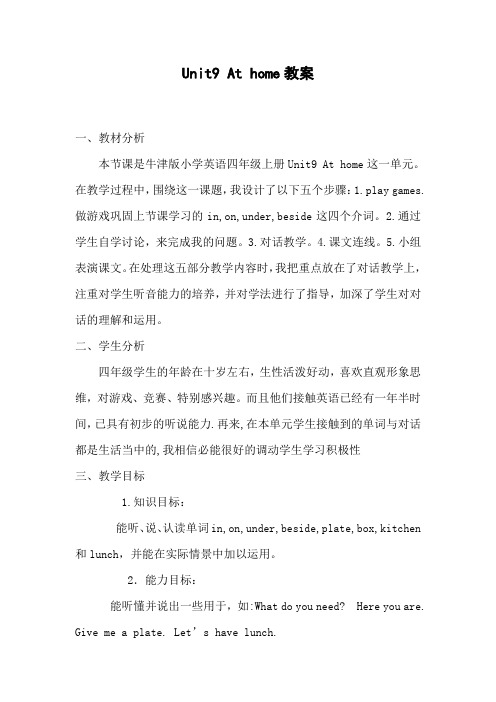
Unit9 At home教案一、教材分析本节课是牛津版小学英语四年级上册Unit9 At home这一单元。
在教学过程中,围绕这一课题,我设计了以下五个步骤:1.play games.做游戏巩固上节课学习的in,on,under,beside这四个介词。
2.通过学生自学讨论,来完成我的问题。
3.对话教学。
4.课文连线。
5.小组表演课文。
在处理这五部分教学内容时,我把重点放在了对话教学上,注重对学生听音能力的培养,并对学法进行了指导,加深了学生对对话的理解和运用。
二、学生分析四年级学生的年龄在十岁左右,生性活泼好动,喜欢直观形象思维,对游戏、竞赛、特别感兴趣。
而且他们接触英语已经有一年半时间,已具有初步的听说能力.再来,在本单元学生接触到的单词与对话都是生活当中的,我相信必能很好的调动学生学习积极性三、教学目标1.知识目标:能听、说、认读单词in,on,under,beside,plate,box,kitchen 和lunch,并能在实际情景中加以运用。
2.能力目标:能听懂并说出一些用于,如:What do you need? Here you are. Give me a plate. Let’s have lunch.能用下列语言简单询问物品的位置:Where is it?Where are they?3.情感目标:培养学生对家的热爱并帮助家里人做些力所能及的事情。
四、课堂导入Step1:Warming up1.Greeting师生问候T:Class begins! Hello,everyone!Ss: Hello,Miss Chen!T:How are you today?Ss: We’re fine,thank you.(评:简单的问候,可以帮助学生适应英语语感,使学生很自然地进入英语学习状态。
)2.Lead-in(play games)游戏T:比一比:教师告诉学生游戏规则:1.根据教师的口型,读出单词。
Module3Unit9Athome(教学设计)沪教牛津版(深圳用)英语四年级上册

Module 3 Unit 9 At home(教学设计)沪教牛津版(深圳用)英语四年级上册一、教学内容分析本节课的主要教学内容是沪教牛津版(深圳用)英语四年级上册Module 3 Unit 9 At home,其中包括家庭日常活动、家具和房间、家庭成员以及日常用语等。
这些内容与学生已有知识紧密联系,学生已经学习过一些日常活动和家庭成员的词汇,如play、sleep、mother、father等。
此外,学生已经具备一定的英语语法基础,如现在进行时、一般现在时等,这有助于理解和运用本节课中的语法结构。
通过学习本节课的内容,学生能够进一步扩展家庭生活相关的词汇,提高英语交流能力,为日常生活中与家人沟通提供更多可能性。
二、核心素养目标1. 语言能力:学生能听懂、会说、会读、会写关于家庭日常活动的词汇和句子,如“play chess”、“do homework”等,并能运用现在进行时描述正在进行的动作。
2. 思维品质:通过学习本节课的内容,学生能够运用所学知识描述自己的家庭生活,培养观察、想象、创新等思维能力。
3. 文化意识:学生能够了解并尊重不同家庭的生活方式和习惯,培养跨文化交际意识。
4. 学习能力:学生能够通过自主学习、合作探究等方式,掌握本节课的知识点,提高学习效率。
本节课的核心素养目标紧密围绕新教材要求,旨在全面提升学生的英语学科核心素养,为他们的终身发展奠定基础。
三、重点难点及解决办法1. 重点:现在进行时的用法及句型结构。
解决方法:通过创设情景,让学生进行角色扮演,运用现在进行时描述正在进行的动作,强化学生对这一时态的理解和应用。
2. 难点:家具和房间的词汇及表达方式。
解决方法:通过图片展示、实物演示等方式,帮助学生直观地学习和记忆家具和房间的词汇,同时引导学生运用所学词汇进行描述和表达。
3. 重点:日常用语的运用。
解决方法:通过创设情景,让学生进行角色扮演,练习日常用语的运用,提高学生的口语表达能力。
2023年沪教牛津版四年级英语上册Unit 9 At home
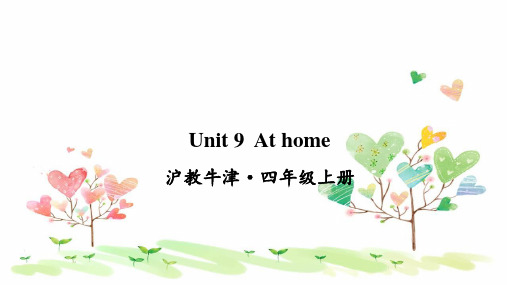
Where is my fish?
1
厨房
Mrs Brown is in her kitchen.
2
3
Ginger the cat is hungry.
Ginger can jump. Now she is on the table.
4
5
Where is the plate now? It is Ginger is full. She is happy, on the floor. Ginger is under but Mrs Brown is angry. the chair.
It’s __b_e_s_id_e_ the table.
Look and Learn
in under
on beside
Ask and answer
S1: Where is …? are
S2: It’s … They’re
S1: Where is the schoolbag? S2: It’s on the bed.
Give me a
2
Where are
3 plate, please.
they?
They’re in the box.
It’s on the
Where is it?
table.
Here you are.
4
Let’s have lunch.
5
Great!
Thank you.
Language points
Learn the sounds
u pupil tube
Judy is a pupil. She has some tubes. She makes music With her tubes.
牛津沪教版四上英语Unit 9 At home 教案
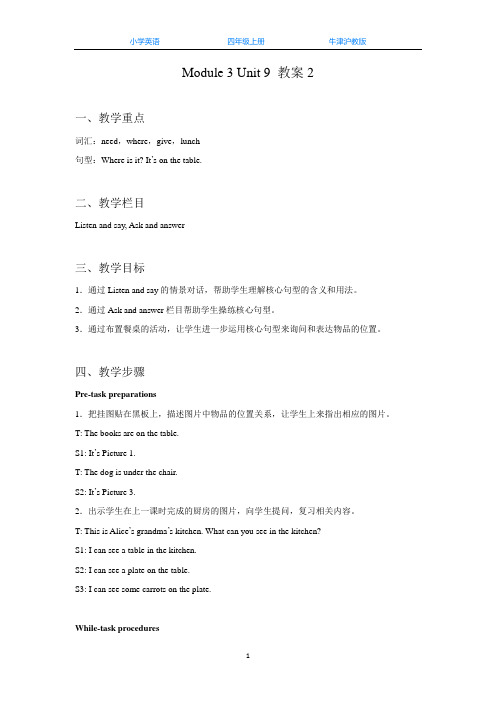
Module 3 Unit 9 教案2一、教学重点词汇:need,where,give,lunch句型:Where is it? It’s on the table.二、教学栏目Listen and say, Ask and answer三、教学目标1.通过Listen and say的情景对话,帮助学生理解核心句型的含义和用法。
2.通过Ask and answer栏目帮助学生操练核心句型。
3.通过布置餐桌的活动,让学生进一步运用核心句型来询问和表达物品的位置。
四、教学步骤Pre-task preparations1.把挂图贴在黑板上,描述图片中物品的位置关系,让学生上来指出相应的图片。
T: The books are on the table.S1: It’s Picture 1.T: The dog is under the chair.S2: It’s Picture 3.2.出示学生在上一课时完成的厨房的图片,向学生提问,复习相关内容。
T: This is Alice’s grandma’s kitchen. What can you see in the kitchen?S1: I can see a table in the kitchen.S2: I can see a plate on the table.S3: I can see some carrots on the plate.While-task procedures1.播放Listen and say的录音,让学生跟读。
随后教师根据录音和图片提问,学生回答。
T: Where are the eggs?S1: They’re in the box.T: Where is the plate?S2: It’s on the table.板书核心句型:Where is it? It’s … Where are they? They’re …让学生跟读数遍。
【沪教版】四年级英语上册Unit 9 At home教学案
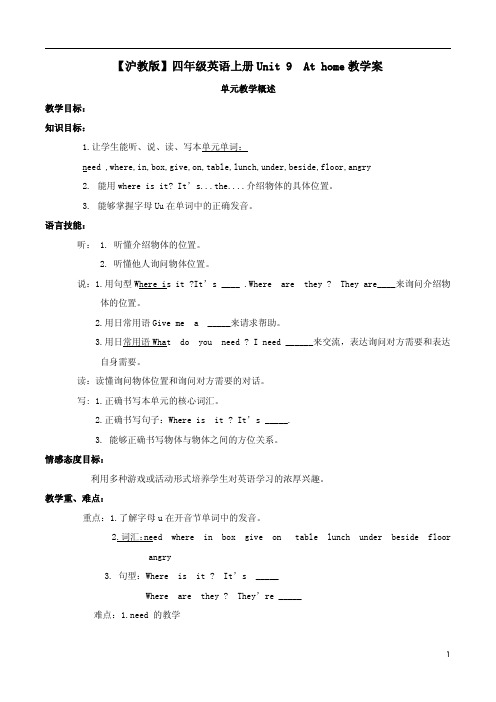
利用多种游戏或活动形式培养学生对英语学习的浓厚兴趣。 教学重难点:
4
重点:1.词汇:need where in box give on table lunch under beside floor
2. 句型:Where is it ? It’s ______ Where are they ? They are _____
练习题:
Module3Unit9Athome(教学设计)沪教牛津版(深圳用)英语四年级上册

Unit 9 At home单元整体教学设计早上奶奶看到Alice的房间很乱,东西到处放,提醒她把房间整理好。
Alice意识到自己的错误。
Alice看到奶奶在做午饭,跑来帮忙,她给奶奶递东西。
午饭做好了,奶奶夸她是个好孩子。
Mrs Brown喜欢听Judy用管子制作的乐曲弹奏音乐。
看!她一边听音乐一边做饭。
等她做完饭,发现饭桌上的鱼肉不见了,原来是小猫偷吃了并把盘子打碎了,MrsBrown很生气。
Period 1 Alice’s roomPeriod 2Helping grandmaPeriod 3Where is my fish?Look and learn. Ask and answer.Listen and say.Think and write.Learn the sounds.Enjoy a story.主题语境授课内容第9单元整体教学设计创设情景第一课时教学设计一、语篇研读What:本节课选自牛津深圳版英语四年级上册Module 3 Unit 9 At home.本部分学习的核心语言是用where提问物品的位置,并正确使用介词做出回答。
通过重点句型描述家里物品的位置。
有助于学生对重点词汇的掌握和巩固。
核心语言使用场景为日常生活常见,易于理解且学生感兴趣,对学生的个人生活态度的养成有积极的作用。
Why: where这一话题,学生除了描述家里的物品的位置,还通过游戏、对话等形式,激发学生的学习兴趣,增强学生学习英语的自信心。
让孩子们珍惜现在的美好生活,唤醒他们爱家爱家人之心。
该话题对学生的价值观渗透和学习习惯的养成都具有极大的挖掘意义,同时可以在描述的过程中,善于发现生活中的美。
How: 本课时遵循《新课程标准(2022)》最新理念,在多媒体课件教学环境下,以文本再构与整体设计为指导,以“任务型”教学和“互助合作”教学模式开展本课教学。
通过多媒体课件和教学过程中通过Alice和Grandma介绍房间内物品的位置这些真实语境的创设,为学生英语运用提供切实可行的情景及交际平台,以语篇、语境带动词句的学习,学生在小组内合作、讨论、交际,创造性运用语言,完成任务活动,通过“复现—递进—渗透—提升”的层层深入进一步提高学生运用语言进行交际的能力,实现课堂中language for use的功能。
沪教版小学四年级英语上册 Unit 9 At home 教案
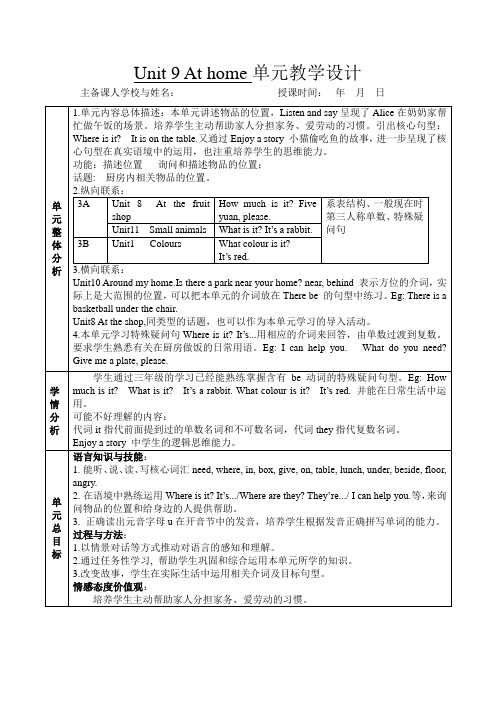
2.T: Thiபைடு நூலகம் is a room.please talk about it.
S1: ….
While-task procedures
1.播放Listen and say的录音,让学生跟读。随后教师根据录音和图片提问,学生回答。
T: Where are the eggs?
S1: They're in the box.
3.正确读出元音字母u在开音节中的发音,培养学生根据发音正确拼写单词的能力。
过程与方法:
1.以情景对话等方式推动对语言的感知和理解。
2.通过任务性学习,帮助学生巩固和综合运用本单元所学的知识。
3.改变故事,学生在实际生活中运用相关介词及目标句型。
情感态度价值观:
培养学生主动帮助家人分担家务、爱劳动的习惯。
Unit8 At the shop,同类型的话题,也可以作为本单元学习的导入活动。
4.本单元学习特殊疑问句Where is it? It’s...用相应的介词来回答,由单数过渡到复数。要求学生熟悉有关在厨房做饭的日常用语。Eg: I can help you. What do you need? Give me a plate, please.
让学生根据图片进行对话活动,操练所学的介词。
S1: Where is ___?
S2:___is on the table.
T:This is my home. Can you describe it?
S1: Where is ___?
S2:___is on the bed.
Post-task activities
第第三课时
1.Read the story on Student’s Book page 44.
沪教版牛津英语四年级上册Unit 9 At home(教案)

Step3 Pre-task preparations
Step4. While-task procedures
Step5 Post taskactivities
T: Good morning, boys and girls.
Ss: Good morning, Ms Tang.
上课时间:
月日
教学准备:课件、录音、练习册。
学习方法指导:复习课文并完成练习
教学过程
教学步骤
教学活动
环节设计意图及效果分析
Step 1 Greeting
Step 2 Revision
Step3 Pre-task preparations
Step4. While-task procedures
Step5 Post task activities
Ss: It’s...
T: What animals do you like?
Ss: I like...
T; What food do you like?
Ss: I like ...
T: What do you like doing?
Ss: I like...
T: What can you do?
Ss: I can ...
T: Can you ...?
Ss: Yes, I can. No, I can’t.
播放录音,跟读对话。P42
Practice in pairs
Where is it?
It’s ...
Listen and enjoy a storyP44
Listen and repeat.
Where is my fish?
沪教2011版四上教学设计unit9
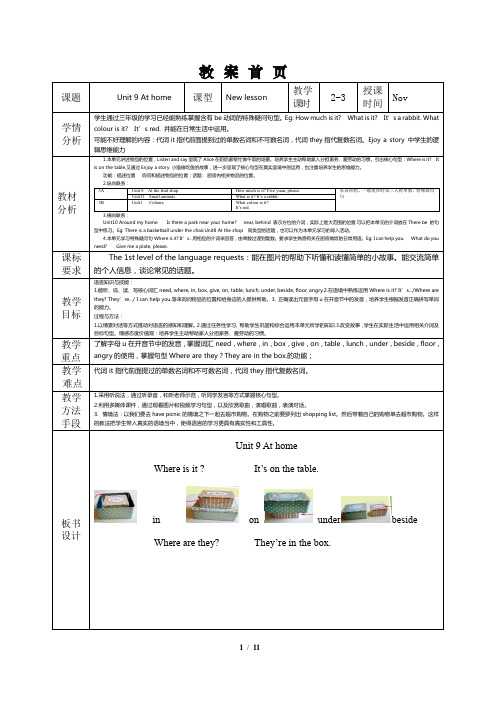
video/teacher, till can say the dialogue skillfully. To read and try to understand them. To present the exercise in P53 in workbooks ,to organize the pupils to do it and correct by reading the answer with the pupils.
and
say the
following the video/teacher, till they can say the dialogue skillfully, to give help when they need. 3,To point out the difficult points and explain them. 4,To present the exercise in P53 in workbooks, to organize the pupils to do it and correct by reading the answer with the pupils.
语言知识与技能: 1.能听、说、读、写核心词汇 need, where, in, box, give, on, table, lunch, under, beside, floor, angry.2.在语境中熟练运用 Where is it? It’s.../Where are they? They’re.../ I can help you.等来询问物品的位置和给身边的人提供帮助。3. 正确读出元音字母 u 在开音节中的发音,培养学生根据发音正确拼写单词 的能力。 过程与方法: 1.以情景对话等方式推动对语言的感知和理解。 2.通过任务性学习, 帮助学生巩固和综合运用本单元所学的知识.3.改变故事, 学生在实际生活中运用相关介词及 目标句型。情感态度价值观:培养学生主动帮助家人分担家务、爱劳动的习惯。
四年级英语上册 Unit9 At home教案 沪教牛津版(三起)

Teaching aims :Basic aims: 1. 能用特殊疑问句Where…? 询问地点。
e.g. Where’s Sam?2. 能用简单的过去式谈论过去的状态。
e.g. He was here at ten o’clock.3. 能用介词短语表示时间。
e.g. He was here at eleven o’clock.Education aims: 培养学生热心助人的思想。
Developing aims: 能运用所学的过去式描述日常生活中已发生的事。
Key points: 1. 能用简单的过去式谈论过去的状态。
2. 能用介词短语表示时间。
Difficult points: 能运用所学的过去式描述日常生活中已发生的事。
Teaching aids: picture cards, toy dog, cassette5B, a cassette player, etc.Preparation: Make a copy of photocopiable page 32.Teaching procedure:教学目标:1.学习新单词: furniture; rug; mirror; picture.2.掌握词组:move the furniture into ….; move in the new house; a picture of …..; take a picture of …...3.会用一般过去时态句型表达物体的变化: It was________. It is _______ now.4.巩固各类介词的用法。
5.会动手操作,利用学具布置一个美丽的居家环境,并描述它们的变化。
教学准备:教具、学具(两人一套)关于家具教学过程:一. Pre-task:1. Daily talk:(1) What’s the weather like today?(2) What day is today? How many days are there in a week? What are they?(3) What’s the date today?(4) What season is it now? Do you like spring?(5) Who time do you get up?(6) Who goes to school by bicycle?(7) Who teaches you Chinese?(8) Which subject do you like best?(9) What’s your favourite animal?(10) Which ruler do you like ?2. Revision:(1) Review the preposition:T: I can’t find my ruler. Where is it ?It’s in the book. It’s behind the book.(under/on/above/near/beside/in front of/between….. 板书:between)(2) Write the words:am; is (过去式)_____ are (过去式)______ roll (过去式)______said (原形)_______ fell (原形)_______ hay (复数) ______(3) Read out the phonetic word./l?mp/ /t?e?/ /teibl/ /s?uf?/ /clok/ /?elf/二. While-task:1. All these are “furniture”.(1) Read “furniture”.(2) f_ _ n _ _ _ _ _ (nurse; picture)(3) No plural form.some furniture ; a piece of furniture/ two pieces of furniture(4) Other furniture: bed/desk/cupboard……(5) move sth. into splmove in the new houseMrs Li is moving the furniture________ the bedroom.Mrs Li buys a new flat. She is going to move _____ the new house next month.2. picture(1) What’s this? It’s a picture. It’s a picture of ……(2) a picture of ……take a picture of sb./splLook! Ben is ______ ___ _______ of Alice.This is ___ _______ _____ Shanghai. Shanghai is beautiful!(3) Here’s a picture of Mrs Li’s sitting-room. Is it nice?What can you see in the picture?3. rug4. mirror ( doctor)Compare: Look at the mirror. Look in the mirror.(Ask someone to act.)5. There is so much furniture in the room. But Mrs Li is not satisfied with it. She moves the furniture. How does she move? Listen to the tape.听录音并出示:The _______ was _________. Where is it now?It’s ______________ now.6. Can you find out more differences? Talk in pairs.7. Writing:Look! This is Mrs Li’s sitting-room. The sofa was_____ the shelf. It is __ ______ ___ the window now. The small lamp was on the round table. It is on the ______ now. The plant was on the ______. It is on the big _____ now. The mirror was ______ the rug. But now it is _________ the picture and the shelf.三. Post-task:1. Mrs Li is still not satisfied with her sitting-room. Can you help her to designa new sitting-room?2. Speaking. (对照第二副图和学生自己摆的图,说说变化。
教案四年级上册第9单元

附件2单元教学设计课题: Unit 9 At home设计人/单位:深圳市宝安区福永小学:幸扬、杨竹深圳市宝安区兴围小学:陈丽萍、巫丹映一、学情分析四年级的学生经历了由低年级向中高年级过渡的心理和知识技能上的转折,已经积累了一定的语言基础,形成了一定的听、说、读、写等能力。
在本单元学习之前,学生已经学习了关于房间物品、厨房用品、食物类等词汇,并能够用相关句型进行讨论。
有关的旧知如图:机地整合。
因此教师要帮助学生滚动旧知,注重学习方法的渗透,注重学生的学习习惯、模仿、表达和思维能力以及自主学习能力的培养,以便他们今后进行更多语言知识的学习和技能的习得。
二、教材分析本单元是《上海版牛津英语》四年级上册Module 3 Unit 9 At home,核心词汇是方位介词on, in, under, beside,核心句型是Where is it?Where are they? 及其回答It’s/They’re....,要求能够正确理解方位介词的含义,并能够准确使用这些方位介词来表达物体所在的位置。
此外,其语音学习部分要求学生能正确读出元音字母u在开音节的发音/ju:/。
本单元是厨房用具、食品等主题教学的延续,如:table,plate, spoon, bowl, chopsticks等(用品类),又如:egg,fish,rice,soup,tomato,meat等(食物类)。
教材又整合了以前所学句型,如Give me...以及It’s / They’re...等,教学内容是以家为主线的对话及故事,生活和学习密切相关。
基于教材内容和学情分析,充分考虑语言学习的渐进性和特殊性,我们将教材进行二次开发,充实了语音学习learn the sound,删减了Think and write,同时在Ask and answer背景下增加了学习文本“a busy girl in the bedroom”,通过创设真实的语境进行学习核心词汇和句型,以达成从初步感知到熟练运用的语言学习目标。
深圳优质课教案 小学四年级英语Unit9 At home教学设计
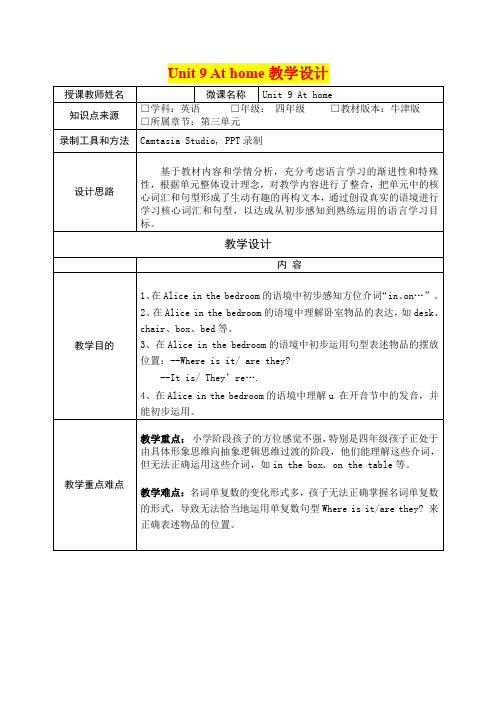
4、在Alice in the bedroom的语境中理解u 在开音节中的发音,并能初步运用。
教学重点难点
教学重点:小学阶段孩子的方位感觉不强,特别是四年级孩子正处于由具体形象思维向抽象逻辑思维过渡的阶段,他们能理解这些介词,但无法正确运用这些介词,如in the box, on the table等。
5.Let’s choose,再次感知文本,培养学生提取信息,模仿语音语调的能力。
教师展示两幅图,播放关于pencil case的片段录音,提出问题:Where’s the ruler?
6.Let’s guess,深入学习文本,突破重、难点。
教师展示空白房间的图片,设悬疑:Where are the shoes?
教学难点:名词单复数的变化形式多,孩子无法正确掌握名词单复数的形式,导致无法恰当地运用单复数句型Where is it/are they?来正确表述物品的位置。
教学过程
1. Let’s sing.活跃课堂气氛,复习知识
教师播放视频Where is it?带着学生一起唱并拍掌
2.Let’s guess,设置悬疑,导入情景
通过问题,引出Alice。
3.Let’s listen,教师出示PPT,介绍新人物Dad,提出问题Is Alice ready?(播放录音:Where’s my pencil case?)
4.Listen and answer.整体感知文本,培养学生听的能力。
教师播放完整录音,提出任务:What does Alice look for?
教学设计
内容
教学目的
1、在AliceБайду номын сангаасin the bedroom的语境中初步感知方位介词“in、on…”。
- 1、下载文档前请自行甄别文档内容的完整性,平台不提供额外的编辑、内容补充、找答案等附加服务。
- 2、"仅部分预览"的文档,不可在线预览部分如存在完整性等问题,可反馈申请退款(可完整预览的文档不适用该条件!)。
- 3、如文档侵犯您的权益,请联系客服反馈,我们会尽快为您处理(人工客服工作时间:9:00-18:30)。
Module 3 Unit 9 教案1一、教学重点词汇:in,under,on,beside,box,table二、教学栏目Look and learn,Ask and answer,Think and write三、教学目标1.帮助学生学习Look and learn的词汇。
2.通过指认游戏和Ask and answer活动,帮助学生理解介词表示的位置。
3.通过Think and write 的练习,考查学生对介词的含义和用法的掌握程度。
四、教学步骤Pre-task preparations1.出示一张厨房的图片,图片中常有的家具和电器,如桌椅、橱柜和冰箱等。
延续Unit 8的购物场景:大家刚刚完成采购回家。
T: Now we come home from the shop. This is the kitchen. What’s in the kitchen?S1: There’s a table.S2: There’s a box. There is a fridge too.T: Where should we put the eggs?S3: In the box.2.出示一张桌子的图片,桌上有cakes,noodles,plates,chopsticks等,让学生看图说一说,复习相关内容。
T: Look at the table in the kitchen. You can see some food. What do you like?S1: I like cakes.T: There are some cakes on the plate.S2: I like noodles.T: There’s a bowl of noodles on the table. Please tell your friend what you (can) see on the table and what you like.S1: I (can) see … I like …S2: I (can) see … I like …While-task procedures1.出示一张厨房的图片,逐一介绍餐具引出box,plate等词,并领读,让学生拼读生词。
T: (point to a box) There’s a box. Box. B-O- X, box.Ss: There’s a box. Box. B-O-X, box.T: (point to a plate)There’s a plate. Plate. P-L-A-T-E, plate.Ss: Plate. P-L-A-T-E, plate.T: The plate is on the table. Can you see the plate?Ss: Yes.T: On the table. The plate is on the table.Ss: On the table. The plate is on the table.T: In the box. The eggs are in the box.2.以图片引出并板书介词on,in,under,beside,随后出示单词卡片,教师领读,学生跟读。
T: (show the flashcard for in) The small box is in the big box. In. I-N, in.Ss: In. I-N,in.然后把四张图片贴在黑板上,给图片编号,让学生根据你对图片的描述,说出相应的图片编号,考查学生对四个介词的理解。
1) The small box is in the big box.2) The small box is on the big box. /The big box is under the small box.3) The small box is under the big box.4) The big box is beside the small box.T: The small box is under the big box. Which picture am I talking about?Ss: It’s Picture 2.也可以自制类似Look and learn的图片,让学生开展指认游戏。
3.把挂图贴在黑板上,根据图片提问,帮助学生操练介词。
T: What’s on the table?Ss: A cat.T: What’s in the box? What’s under the chair?然后让学生根据挂图进行对子活动,操练所学的介词。
S1: What’s in the schoolbag?S2: There are some books.4.让学生根据Ask and answer的图片进行对子问答。
S1: What’s on the bed?S2: There’s a schoolbag on the bed.随后每组学生派代表描述图片。
S1: This is Peter’s room. There’s a bed in the room. There’s a desk and a chair. There’s a computer on the desk. There are three pens on the desk. There’s a box on the floor. There are some books in the box.Post-task activities1.让学生看Think and write的两张图片并回答问题,或两人一组互相问答。
S1: What’s in the box?S2: There are six eggs in the box.然后让学生做Think and write的练习,最后和全班一起核对答案。
2.分发给每位学生Alice’s grandma’s kitchen的图片,要求学生根据教师的描述,将各种物品的简笔画图片放到相应的位置。
T: This is Alice’s grandma’s kitchen. There’s a table in the kitchen. There are some plates on the table. There are some carrots on the plates. There’s a box under the table. There are some eggs in the box.然后学生两人_组一起核对各自完成的厨房图。
S1: This is Alice’s grandma’s kitchen. There’s a table in the kitchen. There’s a box on the table.S2: No. The box is under the table.请个别学生上来展示他们完成的厨房图片,并作简单的介绍。
S1: This is Alice’s grandma’s kitchen. There’s a table in the kitchen …牛津上海版英语四年级上册知识点整理Unit 1 Meeting new people生词: eleven twelve thirte en fourteen fifteen sixteen newmorning classmate her name sit afternoon his句型:My/His/Her name is ... Nice to meet you. See you.He’s/She’s ... (age) This is my... Good morning/afternoon语法:形容词性物主代词 my, her, his, your在英语中有物主代词,它可以分成名词性的和形容词性的。
形容词性物主代词相当于形容词,置于名词前,在句子中用于修饰名词,做定语,后面必须跟一个名词。
例如:This is my brother. His name is Tom. 这是我的哥哥。
他叫汤姆。
形容词性物主代词有人称和数的变化,单数形式:my 我的,your 你的,his /her/its 他的、她的、它的。
复数形式:our (我们的),your (你们的),their (他们的)。
Unit2 Can you swim?生词:run fast fly draw read write swim jump welcomebut skate dance cat mouse bird rabbit fish elephant句型:I/He/She/Kitty/My sister can ... I/He/She can’t…Can you/he/she…? What can you/he/she do?Welcome to Super Show.A fish can swim. An elephant can ran fast.语法: 1. 情态动词can 意思是“会,能”,表示会做某事。
句子结构:肯定句:主语 + can + do( 动词原形)否定句:主语 + can + not + do( 动词原形)一般疑问句:Can you/he/she/they run fast ?特殊疑问句:What can you/he/she/they do ?例如:My friend can ride a bicycle. I can’t swim.My brother can hear the bird. I can’t draw flowers.注:can 的否定有两种书写形式can’t和 cannot 2. 连词 butBut 是个表示转折关系的并列连词,意思是“但是,然而”。
例如: I can run, but I can ’ t swim. 我会跑但是我不会游泳。
My sister can sing, but she can ’ t dance. 我妹妹会唱歌但是不会游Unit 3 Are you happy?生词: happy hungry thirsty sad full tired bird see drink bottle a new kite look at have some water/biscuits.little stones drink the water very thirsty have a good idea语法:I’m/He/She/Peter is happy/hungry.Are you sad/tired? Yes, I am/No, I’m mot.Is Kitty thirsty? Yes, she is/No, she isn’t.How do you feel? I’m/We’re...Module2 Me, my family and friendsUnit 4 Jill ’ s family生词:father mother parent brother sister uncle aunt grandfather grandmother grandparent me cousina big family Uncle John’s son Dan’s father语法:I have two cousins. I don’t have any cousins.Do you have any ...? Yes, I do. /No, I don’t.How old is your brother? He is 11 years old.Who is this/that? This/That is my uncle/me.Welcome to my home.Is this your brother? Yes, he is./No, he isn’t.Unit5 My friends生词: shirt T-shirt skirt shorts dress brown green redwhite black blue pink yellow purple a pair of shortsorange get out tooth/teeth sharp a brown shirt fly a kitean orange dress ride a bike skate afraid语法:I have a black T-shirt. He/She has a pair of brown shortsUnit6 My parents生词: doctor nurse teacher student fire man cook bus driverJill’s father kid help people fire play with语法: What does your father do? He/She is a fireman.What do you/your parents do? I’m/My father is a doctor.Is your sister a nurse? Yes, she is/No, she i sn’t.Don’t play with fire. Yes, Mr Xu.Are you afraid of fire? No. I like my job.Module3 Places and activitiesUnit7 At school生词:school office busy computer many library tryPlayground classroom toilet animal pupil forest firstClimb trees teac her’s office an animal school no classroom语法:There be 句型是英语中常用句型,意思是“ 有” ,表示“ 人或事物的存在” 或“ 某地有某物” 。
